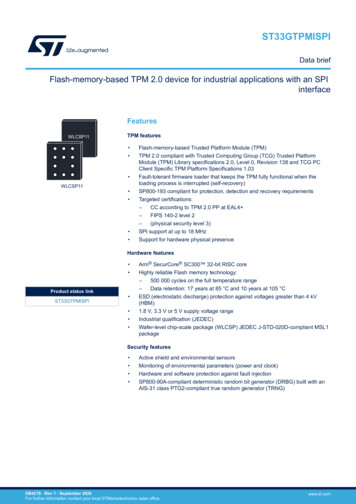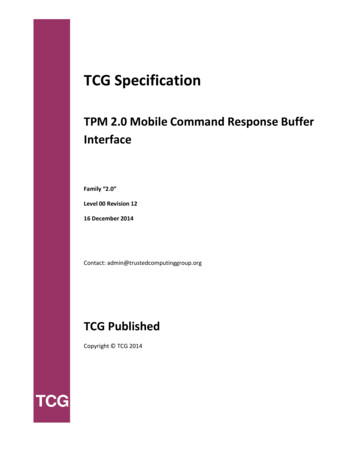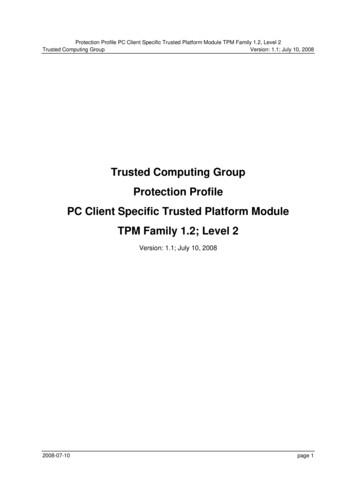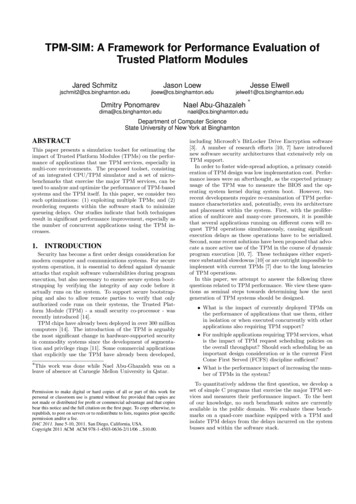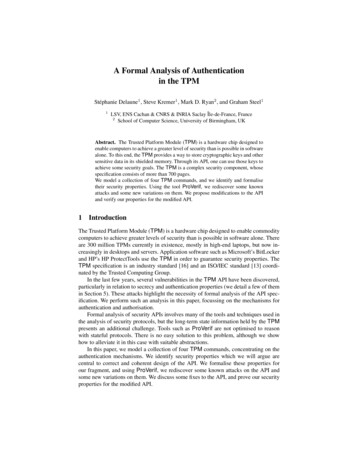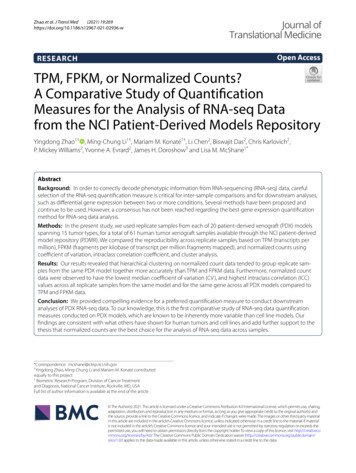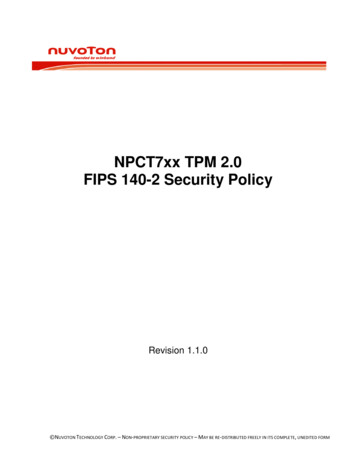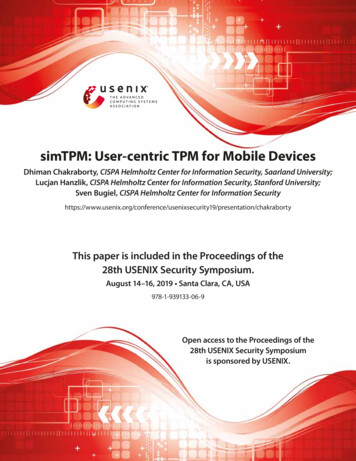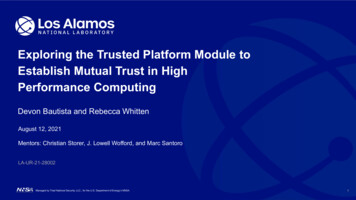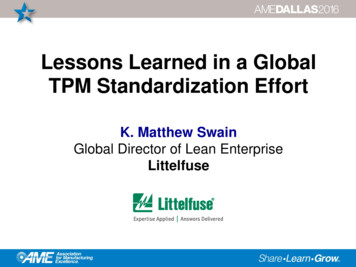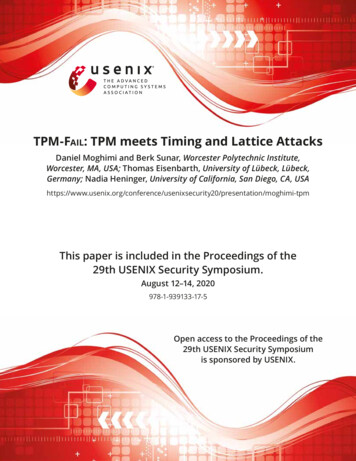
Transcription
TPM-Fail: TPM meets Timing and Lattice AttacksDaniel Moghimi and Berk Sunar, Worcester Polytechnic Institute,Worcester, MA, USA; Thomas Eisenbarth, University of Lübeck, Lübeck,Germany; Nadia Heninger, University of California, San Diego, CA, y20/presentation/moghimi-tpmThis paper is included in the Proceedings of the29th USENIX Security Symposium.August 12–14, 2020978-1-939133-17-5Open access to the Proceedings of the29th USENIX Security Symposiumis sponsored by USENIX.
TPM-FAIL: TPM meets Timing and Lattice AttacksDaniel Moghimi1 , Berk Sunar1 , Thomas Eisenbarth1, 2 , and Nadia Heninger31 WorcesterPolytechnic Institute, Worcester, MA, USAof Lübeck, Lübeck, Germany3 University of California, San Diego, CA, USA2 UniversityAbstractTrusted Platform Module (TPM) serves as a hardwarebased root of trust that protects cryptographic keys from privileged system and physical adversaries. In this work, we perform a black-box timing analysis of TPM 2.0 devices deployed on commodity computers. Our analysis reveals thatsome of these devices feature secret-dependent executiontimes during signature generation based on elliptic curves. Inparticular, we discovered timing leakage on an Intel firmwarebased TPM as well as a hardware TPM. We show how thisinformation allows an attacker to apply lattice techniques torecover 256-bit private keys for ECDSA and ECSchnorr signatures. On Intel fTPM, our key recovery succeeds after about1,300 observations and in less than two minutes. Similarly, weextract the private ECDSA key from a hardware TPM manufactured by STMicroelectronics, which is certified at CommonCriteria (CC) EAL 4 , after fewer than 40,000 observations.We further highlight the impact of these vulnerabilities bydemonstrating a remote attack against a StrongSwan IPsecVPN that uses a TPM to generate the digital signatures forauthentication. In this attack, the remote client recovers theserver’s private authentication key by timing only 45,000authentication handshakes via a network connection.The vulnerabilities we have uncovered emphasize the difficulty of correctly implementing known constant-time techniques, and show the importance of evolutionary testingand transparent evaluation of cryptographic implementations.Even certified devices that claim resistance against attacksrequire additional scrutiny by the community and industry, aswe learn more about these attacks.1IntroductionHardware support for trusted computing has been proposedbased on trusted execution environments (TEE) and secureelements such as the Trusted Platform Module (TPM) [40].Computer manufacturers have been deploying TPMs on desktop workstations, laptops, and servers for over a decade. WithUSENIX Associationa TPM device attached to the computer, the root of trust canbe executed in a separate hardened cryptographic core, whichprevents even a fully compromised OS from revealing credentials or keys to adversaries. TPM 2.0, the latest standard, isdeployed in almost all modern computers and is required bysome core security services [38]. TPM 2.0 supports multiplesignature schemes based on elliptic curves [63].TPMs were originally designed as separate hardware modules, but new demands have resulted in software-based implementations. The physical separation of the TPM fromthe CPU is an asset for protection against system-leval adversaries [3]. However, its lightweight design and low-bandwidthbus connection prevents the TPM from being used as a securecryptographic co-processor for high-throughput applications.TEE technologies such as ARM TrustZone [2] are a morerecent approach to bringing trusted execution right into theCPU, at minimal performance loss. Firmware TPMs (fTPM)can run entirely in software within a TEE like ARM Trustzone [48]. In a cloud environment, a software-virtualizedTPM device will be executed within the trust boundary ofthe hypervisor [23, 39, 46]. In this case, user applicationsstill benefit from the defense against attacks on the guest OS.Virtual TPMs may or may not rely on a physically presentTPM hardware. Intel Platform Trust Technology (PTT), introduced in Haswell processors, is based on fTPM and follows ahybrid hardware/software approach to implement the TPM2.0 standard, as discussed in Section 2.2. By enabling IntelPTT, computer manufacturers do not need to deploy dedicatedTPM hardware.Side-channel attacks are a potential attack vector for secure elements like TPMs. These attacks exploit the unregulated physical behavior of a computing device to leak secrets.Processing cryptographic keys may expose secret-dependentsignal patterns through physical phenomena such as powerconsumption, electromagnetic emanations, or timing behavior [10,35,47]. A passive adversary who observes such signalscan reconstruct cryptographic keys and break the confidentiality and authenticity of a computing system [16,36]. The TPM,as defined by the Trusted Computed Group (TCG), attempts29th USENIX Security Symposium2057
to mitigate the threat of physical attacks through a rigorousand lengthy evaluation and certification process. Most physical TPM chips have been certified according to CommonCriteria, which involves evaluation through certified testinglabs. Tests are conducted according to protection profiles.For TPM, a specific TCG protection profile exists, which requires the TPM to be protected against side-channel attacks,including timing attacks [62, p. 23].TPMs have previously suffered from vulnerabilities dueto weak key generation [41]. However, it is widely believedthat the execution of cryptographic algorithms is secure evenagainst system adversaries. Indeed, TPM devices are expectedto provide a more reliable root of trust than the OS by keepingcryptographic keys secure. Contrary to this belief, we showthat these implementations can be vulnerable to remote attacks. These attacks not only reveal cryptographic keys, butalso render modern applications using the TPM less securethan without the TPM.1.1Our ContributionIn this work, we perform a black-box timing analysis of TPMdevices. Our analysis reveals that elliptic curve signature operations on TPMs from various manufacturers are vulnerableto timing leakage that leads to recovery of the private signingkey. We show that this leakage is significant enough to beexploited remotely by a network adversary. In summary, ourcontribution includes: An analysis tool that can accurately measure the execution time of TPM operations on commodity computers.Our developed tool supports analysis of command response buffer (CRB) and TPM Interface Specification(TIS) communication interfaces. The discovery of previously unknown vulnerabilities inTPM implementations of ECDSA and ECSchnorr signature schemes, and the pairing-friendly BN-256 curveused by the ECDAA signature scheme. These ellipticcurve signature schemes are supported by the TPM 2.0standard. We apply lattice-based techniques to recoverprivate keys from these side-channel vulnerabilities. A remote attack that breaks the authentication of a VPNserver that uses Intel fTPM to store the private certificatekey and to sign the authentication message. We demonstrate the efficacy of our attack against the strongSwanIPsec-based VPN Solution that uses the TPM device tosign authentication messages.Our study shows that these vulnerabilities exist in devicesthat have been validated based on FIPS 140-2 Level 2 andCommon Criteria (CC) EAL 4 , which is the highest internationally accepted assurance level in CC, in a protection profilethat explicitly includes timing side channels.205829th USENIX Security Symposium1.2Experimental SetupWe tested Intel fTPM on multiple computers running IntelManagement Engine (ME), and we demonstrate key recoveryattacks on these machines. We also tested multiple machinesmanufactured with dedicated TPM hardware, as discussedin Section 3. All the machines run Ubuntu 16.04 with kernel4.15.0-43-generic. We used the tpm2-tools1 and tpm2-tss2software packages and the default TPM kernel device driverto interact with the TPM device. Our analysis tool takes advantage of a custom Linux loadable kernel module (LKM).The remote attacks are demonstrated on a simple localarea network (LAN) with the attacker and victim workstationconnected through a 1 Gbps switch manufactured by Netgear.1.3Coordinated DisclosureWe informed the Intel Product Security Incident ResponseTeam (iPSIRT) of our findings regarding Intel fTPM on February 1, 2019. Intel acknowledged receipt on the same day,and responded that an outdated version of Intel IPP has beenused in the Intel fTPM on February 12, 2019. Intel assignedCVE-2019-11090 and awarded us separately for three vulnerabilities. They issued a firmware update for Intel Management Engine (ME) including patches to address this issue onNovember 12, 2019.We informed STMicroelectronics of our findings regardingthe TPM chip flaw on May 15, 2019. They acknowledgedreceipt on May 17, 2019. We shared our tools and techniqueswith STMicroelectronics. They assigned CVE-2019-16863and provided us an updated version of their TPM product forverification. We tested the updated hardware and confirmedthat it is resistant to our attacks on September 12, 2019.2Background2.1Trusted Platform ModuleTPMs are secure elements which are typically dedicated physical chips with Common Criteria certification at EAL 4 andhigher, and thus provide a very high level of security assurance for the services they offer [12]. As shown in Figure 1,the TPM, including components like cryptographic engines,forms the root of trust. On a commodity computer, the hostprocessor is connected to the TPM via a standard communication interface [59]. For trusted execution of cryptographicprotocols, applications can request that the OS interact withthe TPM device and use various cryptographic engines thatsupport hash functions, encryption, and digital signatures. TheTPM also contains non-volatile memory for secure storage ofcryptographic parameters and configurations. As discussedin Section 5.3, for instance, a Virtual Private Network (VPN)1 https://github.com/tpm2-software/tpm2-tools2 https://github.com/tpm2-software/tpm2-tsscommit c66e4f0commit 443455bUSENIX Association
UntrustedTrustedHost CPUMain MemorySystem SoftwareApplicationsRemote AttestationRequestTPMPCR RegistersCrypto EngineRandom NumberGeneratorExecutionEngineVolatile MemoryNon-volatileMemoryFigure 1: The trusted components of a TPM include the PCRregisters, crypto engine, and random number generator. Otherhardware components, system software, and applications areconsidered untrusted.application can use the TPM to securely store authenticationkeys and to perform authentication without direct access to theprivate key. TPM also supports remote attestation, in whichthe TPM will generate a signature using an attestation keywhich is normally derived from the device endorsement key.The endorsement key is programmed into the TPM duringmanufacturing. Later on, the signature and the public attestation key can be used by a remote party to attest to the integrityof the system, and the public endorsement key can be used toverify the integrity of the TPM itself.Attacks on TPM: The traditional communication interface between dedicated TPM hardware and the CPU is theLow Pin Count (LPC) bus, which has been shown to be vulnerable to passive eavesdropping [33]. There exist attacksto compromise the PCRs based on short-circuiting the LPCpins [31, 55], software-based attacks on the BIOS and bootloader [11, 31], and attacks exploiting vulnerabilities relatedto the TPM power management [24]. Nemec at al. developed the “Return of Coppersmith’s Attack” (ROCA), whichdemonstrated passive RSA key recovery from the public keyresulting from the special structure of primes generated onTPM devices manufactured by Infineon [41]. The remote timing attacks that we demonstrate are orthogonal to the keygeneration issues responsible for ROCA. As originally suggested by Spark. et al. [55], we demonstrate a class of remotetiming attack against TPM devices that are deployed withinhundreds of thousands of desktop/laptop computers.2.2Intel Management EngineThe Intel management engine (ME) provides hardware support for various technologies such as Intel Active Management Technology (AMT), Intel SGX Enhanced Privacy ID(EPID) provisioning and attestation, and platform trust technology (PTT) [64]. Intel ME is implemented as an embeddedcoprocessor that is integrated into all Intel chipsets. This coprocessor runs modular firmware on a tiny microcontroller.Since the Skylake generation, Intel has used the MINIX3USENIX AssociationOS running on a 32-bit Quark x86 microcontroller3 . Thesefirmware modules, and in particular the cryptographic module,provide commonly used functions for a variety of services.Previous reverse-engineering efforts have uncovered someof the secrets of the Intel ME implementation [54], as wellas classical software flaws and vulnerabilities related to theJTAG that can be abused to compromise Intel ME [18–20].Intel PTT, which is essentially a firmware-based TPM, hasbeen implemented as a module that runs on top of the IntelManagement Engine (ME). Intel PTT executes on a generalpurpose microcontroller, but since it executes independentlyfrom the host processor components, it resembles a more secure hybrid approach than the original Intel fTPM [48], whichexecutes on a TEE on the same core. The exact implementation of the cryptographic functions that are shared by IntelPTT, EPID, and other cryptographically relevant services isnot publicly available.2.3Elliptic Curve Digital SignaturesThe Elliptic Curve Digital Signature Algorithm(ECDSA) [30] is an elliptic curve variant of the Digital Signature Algorithm (DSA) [22] in which the primesubgroup in DSA is replaced by a group of points on anelliptic curve over a finite field. The ECDSA key generationprocess starts with the selection of an elliptic curve, specifiedby the curve parameters and the base field Fq over which thecurve is defined, and a base point P E of cryptographicallylarge order n in the group operation.ECDSA Key Generation:1. Randomly choose a private key d Z n .2. Compute the curve point Q dP E .The private, public key pair is (d, Q).ECDSA Signing: To sign a message m {0, 1} 1. Choose a nonce/ephemeral key k Z n .2. Compute the curve point kQ, and compute the x coordinate r (kQ)x .3. Compute s k 1 (H(m) dr) mod n, where H(.) represents a cryptographic hash function such as SHA-256.The signature pair is (r, s).The Schnorr digital signature scheme [53] has been similarly extended to support elliptic curves. Among multipledifferent standards for Elliptic Curve Schnorr (ECSchnorr),the TPM 2.0 is based on the ISO/IEC 14888-3 standard.The key generation for ECSchnorr is similar to ECDSA.The signing algorithm is defined as the following:ECSchnorr Signing: To sign a message m {0, 1} ,1. Choose an ephemeral key k Z n .2. Compute the elliptic curve point kQ and compute the xcoordinate xR (kQ)x .3. Compute r H(xR m) mod n.3 Quarkmicrocontrollers have a working frequency of 32 MHz [28].29th USENIX Security Symposium2059
4. Compute s (k dr) mod n.The signature pair is (r, s).In practice, elliptic curve signature schemes are implemented for a small set of standard curves, which have beenvetted for security. The targeted elliptic curves that we will discuss in this paper are the p-256 [22] and bn-256 [4] curves,as supported by TPM 2.0. bn-256 can optionally be used withECDSA and ECSchnorr schemes, but it is essential for theelliptic-curve direct anonymous attestation (ECDAA) scheme,since ECDAA requires a pairing-friendly curve like bn-256.Since it is not relevant to our attack, we omit discussion ofECDAA and signature verification.2.4Lattice and Timing AttacksThe Hidden Number Problem: Boneh and Venkatesan [8]formulated the hidden number problem (HNP) as the following: Let α Z p be an integer that is to remain secret. In thehidden number problem, one is given a prime p, several uniformly and independently randomly chosen integers ti in Z p ,and also integers ui that represent the l most significant bits ofαti mod p. The ti and ui satisfy the property αti ui p/2l .Boneh and Venkatesan showed how to recover the secret integer α in polynomial time using lattice-based algorithms withprobability greater than 1/2, if the attacker learns enoughsamples from the l most significant bits of αti mod p.Lattice Attacks: Researchers have applied lattice-based algorithms for the HNP to attack the DSA and ECDSA signingalgorithms with partially known nonces [26, 42, 43, 49]. As adirect consequence, implementation of these signature algorithms in standard cryptographic libraries have been shown tobe vulnerable when the implementation leaks partial information about the secret nonce through side channels [5,21,45,51].Lattice attacks can also solve similar HNP instances to recover private keys for other signature schemes such as EPIDin the presence of side channel vulnerabilities [14]. Ronen etal. [50] connected padding oracle attacks to the HNP. Whilethere exist other variants of the HNP, such as the modular inversion hidden number problem [7] and the extended hiddennumber problem [25], our attack is based on the original HNPwhere the attacker learns information about the most significant bits of the nonce. A second family of algorithms for solving the HNP is based on Fourier analysis. Bleichenbacher’salgorithm [6] was the first to make this connection. Bleichenbacher’s Fourier analysis techniques can be augmented withlattice reduction for the first stage of the attack, as shown byDe Mulder et al. [15]. Bleichenbacher’s original algorithmis targeted at a scenario where only a very small amounts ofinformation is leaked by each signature, and the attacker canquery for a very large number of signatres; the De Muldervariant requires fewer signatures, but in this setting the abovelattice techniques are more efficient. We use lattice attacksbecause they are more efficient for the amount of side-channelinformation we obtain.206029th USENIX Security SymposiumTiming Attacks: Kocher showed that secret-dependenttiming behavior of cryptographic implementations can beused to recover secret keys [32]. Since then, constant-timeoperation, or at least secret-independent execution time, hasbecome a common requirement for cryptographic implementations. For example, the Common Criteria evaluation of cryptographic modules, which is common for standalone TPMs,includes testing for timing leakage. Brumley et al. showedthat remote timing attacks can be feasible across networks bymounting an attack against RSA decryption as it was implemented in OpenSSL [10]. Similarly, the OpenSSL ECDSAimplementation was vulnerable to remote timing attacks [9].In the latter work, they also showed how lattice attacks can beused to recover private keys based on the nonce information.However, the practicality of such attacks has been questionedin the real world [66] due to noise and low timing resolution.In comparison, we show that such timing attacks have agreater impact on TPMs, because of the high-resolution timing information and their specific threat model of a systemlevel attacker. Timing side channels have also been used toattack the implementation of cryptographic protocols. Forexample, both the Lucky 13 attack [1] and Bleichenbacher’sRSA padding oracle attack [37] exploit remote timing.3Timing Attack and Leaky NoncesOur timing attacks have three main phases:Phase 1: The attacker generates signature pairs and timing information and uses this information to profile a givenimplementation. The timing oracle can be based on a remotesource, for example the network round-trip time, or preciselocal source, as discussed in Section 3.1. In this pre-attackprofile stage, the attacker knows the secret keys and can usethis to recover the nonces, and thus has perfect knowledge ofthe correlation between timing and partial information aboutthe secret nonce k that is leaked through this timing oracle.As explained in Section 3.3, in our case this bias is related tothe number of leading zero bits (LZBs) in the nonce, which isrevealed by the timing oracle. For the vulnerable TPM implementations in this paper, signing a message with a nonce thathas more leading zero bits is expected to take less time.Phase 2: To mount a live attack, the attacker has accessto a secret-related timing oracle as above and collects a listof signature pairs and timing information from a vulnerableTPM implementation. The attacker uses the signature timinginformation obtained during the profiling phase to filter outsignatures and only keep the signature pairs (ri , si ) that havea specific bias in the nonce ki .Phase 3: The attacker applies lattice-based cryptanalysisto recover the private key d from a list of filtered signatureswith biased nonces ki . In the noisier cases, e.g. with timingscollected remotely over the network, filtering may not workperfectly and the lattice attack may fail. In these cases, theattacker can randomly chose subsets of filtered signatures,USENIX Association
and repeatedly run the lattice attack with the hope of leavingthe noisy samples out.This section describes our custom timing analysis tool, andshows how a privileged adversary can exploit the OS kernel toperform accurate timing measurement of the TPM, and thusdiscover and exploit timing vulnerabilities in cryptographicimplementations running inside the TPM. We then report thevulnerabilities we discovered related to elliptic curve digitalsignatures. Later, in Section 5, we combine the knowledgeof these vulnerabilities with the lattice-based cryptanalysisdiscussed in Section 4 to demonstrate end-to-end key recoveryattacks under various practical threat models4 .3.1Precise Timing MeasurementThe TPM device runs at a much lower frequency than the hostprocessor, as it is generally implemented based on a powerconstrained platform such as an embedded microcontroller. Amodern Intel core processor’s cycle count can be used as ahigh-precision time reference to measure the execution timeof an operation inside the TPM device. In order to performthis measurement on the host processor entirely from softwarewhile minimizing noise, we need to make sure that we canread the processor’s cycle count right before the TPM devicestarts executing a security-critical function, and right after theexecution is completed.The Linux kernel supports device drivers to interact withthe TPM that support various common communication standards. Our examination of the TPM kernel stack and differentTPM 2.0 devices on commodity computers suggests that Intel fTPM uses the command response buffer (CRB) [60], anddedicated hardware TPM devices use the TPM Interface Specification (TIS) [59] to communicate with the host processor.The Linux TPM device driver implements a push mode ofcommunication with these interfaces, where the OS sends theuser’s request to the device, and checks in a loop whether theoperation has been completed by the device or not. As soonas the completed status is detected, the OS reads the responsebuffer and returns the results to the user. The status check forthis operation initially waits for 20 milliseconds to performanother status check, and it doubles the wait time every timethe device is in a pending state.This push mode of communication makes timing measurement of TPM operations from user space less efficient andprone to noise. To mitigate the noise, we initially developa kernel driver that installs hooks into the CRB and TIS interfaces to modify the described behavior, and measure thetiming of TPM devices as accurately as possible. Later, wemove to more realistic settings, i.e. noisy user level accesswithout root privileges, then to settings where the TPM isaccessed remotely over the network.4 Thesource code for our timing analysis tool, lattice attack scripts, and asubset of the data set is available at github.com/VernamLab/TPM-Fail.USENIX AssociationTable 1: The CRB control area: The CRB interface does notprescribe a specific access pattern to the fields of the ControlArea. The Start and Status fields are used to start a TPMcommand and check the status of the device, ncel000408Power state transition controlStatusAbort command processingStartInterrupt ControlCommand SizeCommand AddressResponse SizeResponse Address0c10181c2428A command is available for processingReservedSize of the Command (CMD) BufferPhysical address of the CMD BufferSize of the Response (RSP) BufferPhysical address of the RSP Buffer3.1.1CRB Timing MeasurementCRB supports a control area structure to interface withthe host processor. The control area, as shown in Table 1,is defined as a memory mapped IO (MMIO) on the LinuxOS in which the TPM drivers communicate with the deviceby reading from or writing to this data structure. We installa hook on the crb send procedure that is responsible forsending a TPM command to the device over the CRB interface.By default, the driver sets the Start field in the control areaafter preparing the command size and address of the commandbuffer to trigger the execution of the command by the device.Later on, the device will clear this bit when the command iscompleted. Listing 1 shows the modification of crb send, inwhich the Start field is checked in a tight loop after trigger.As a result, the crb send will only return upon completionof the command, and cycle counts are measured as close tothe device interface as possible.t rdtsc () ;iowrite32 (CRB START INVOKE, &g priv regs t ctrl start);while (( ioread32(&g priv regs t ctrl start ) &CRB START INVOKE) CRB START INVOKE);tscrequest [ requestcnt ] rdtsc () t ;Listing 1: CRB Timing Measurement3.1.2TIS Timing MeasurementSimilarly, the TIS driver uses a MMIO region to communicate with the TPM device. The first byte of this mappedregion indicates the status of the device. To measure accurate timing of the TPM over TIS, we install a hook on thetpm tcg write bytes procedure. In the modified handler(Listing 2), we check if the write operation issued by the TISdriver stack is related to the trigger for the command execution, TPM STS GO. If this is the case, we check the buffer forTPM STS DATA AVAIL status, indicating the completion of29th USENIX Security Symposium2061
the command execution, in a tight loop. Similar to CRB, thecycle counts are measured close to the device interface.enum tis status {TPM STS GO 0x20,TPM STS DATA AVAIL 0x10, .};int tpm tcg write bytes handler ( struct tpm tis data data ,u32 addr , u16 len , u8 value){.if ( len 1 && value TPM STS GO &&TPM STS(data locality) addr) {t rdtsc () ;iowrite8 ( value , phy iobase addr);while (!( ioread8 (phy iobase addr) &TPM STS DATA AVAIL));tscrequest [ requestcnt ] rdtsc () t ;} .Listing 2: TIS Timing MeasurementFigure 2: Histogram of ECDSA (NIST-256p) signature generation timings on the STMicroelectronics TPM as measuredon a Core i7-8650U machine for 40,000 observations.10 78.85We profiled the timing behavior of the ECDSA signatureschemes using the NIST-256p curve. As shown in Table 2,we report the average number of CPU cycles to compute theECDSA signatures for the aforementioned platforms. Thisaverage cycle count for Intel fTPM is different for each configuration due to the CPU’s working frequency, but the averageexecution time is similar in different configurations: for example, we observe the highest cycle count on the Core i7-7700machine, which is a desktop processor with base frequencyof 3.60 GHz. We can calculate the average execution time forECDSA on Intel fTPM as 4.7 108 cycles/3.6 GHz 130ms.As mentioned in Section 2.2, the working frequency of theIntel fTPM device is relatively slow, which facilitates our observation of timing vulnerabilities on such platforms. As thenumbers for the dedicated hardware TPM chips suggest, thereis a significant difference in execution time between differentimplementations among various manufacturers.To test the ECDSA signature scheme, we generated a single ECDSA key using the TPM device, and then measuredthe execution time for ECDSA signature generation on thedevice. As mentioned in Section 2.3, the security of ECDSAsignatures depends on the randomly chosen nonce. The TPMdevice must use a strong random number generator to generate this nonce independently and randomly for each signingoperation to preserve the security of the ECDSA scheme [43].Our analysis reveals that Intel fTPM and the dedicated TPMmanufactured by STMicroelectronics leak information aboutthe secret nonce in elliptic curve signature schemes, whichcan lead to efficient recovery of the private key. As discussedin Section 6, we also observe non-constant-time behavior bythe TPM manufactured by Infineon which does not appearto expose an exploitable vulnerability. From our experimental observations, only the TPM manufactured by Nuvotonexhibits constant-time behavior for ECDSA (Figure 21).20628.8Timing Analysis of ECDSA29th USENIX Security SymposiumCPU 0251252253254255256Bit LengthFigure 3: Box plot of ECDSA (NIST-256p) signature generation timings by the bit length of the nonce. We observe a clearlinear relationship between the two for the STMicroelectronics TPM. Each box plot indicates the median and quartiles ofthe timing distribution.3.3Discovered VulnerabilitiesSTMicroelectronics ECDSA Scalar Multiplication: Figure 2 shows an uneven distribution for the STMicroelectronics TPM where there are more leading zero bits (LZBs) onthe left side of the distribution. We used the private key dto compute each nonce ki for each profiled signature (ri , si )by computing ki s 1i (H(m) dri ) mod n. Figure 3 showsa linear correlation between the execution time and the bitlength of nonce. This shows that
TPM-FAIL: TPM meets Timing and Lattice Attacks Daniel Moghimi1, Berk Sunar1, Thomas Eisenbarth1, 2, and Nadia Heninger3 1Worcester Polytechnic Institute, Worcester, MA, USA 2University of Lübeck, Lübeck, Germany 3University of California, San Diego, CA, USA Abstract Trusted Platform Module (TPM) serves as a hardware-based root of trust that protects cryptographic keys from priv-

